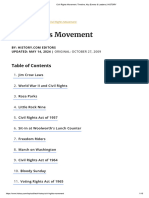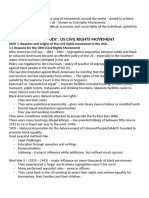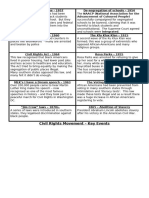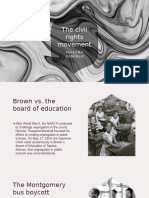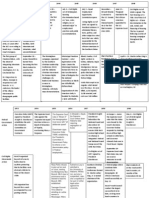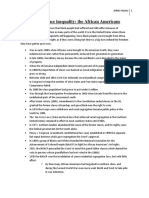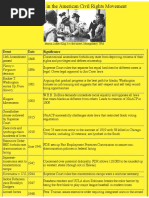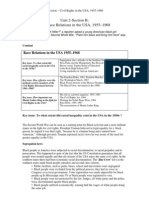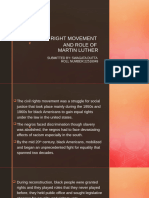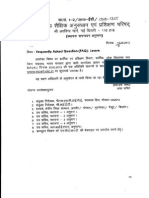0 ratings0% found this document useful (0 votes)
Civil Rights Movement
Civil Rights Movement
Uploaded by
api-306462683The document summarizes key events and developments in the American Civil Rights Movement during the 1950s and 1960s. It discusses pivotal Supreme Court cases like Brown v. Board of Education, civil rights protests like the Montgomery Bus Boycott led by Martin Luther King Jr., and violent resistance to integration exemplified by the Little Rock Nine. It also outlines major civil rights legislation of the era, influential Black leaders and organizations, and landmark protests including the 1963 March on Washington and Selma to Montgomery marches. The assassination of Martin Luther King Jr. in 1968 is noted for sparking riots across the US in the aftermath.
Copyright:
© All Rights Reserved
Available Formats
Download as DOCX, PDF, TXT or read online from Scribd
Download as docx, pdf, or txt
Civil Rights Movement
Civil Rights Movement
Uploaded by
api-3064626830 ratings0% found this document useful (0 votes)
The document summarizes key events and developments in the American Civil Rights Movement during the 1950s and 1960s. It discusses pivotal Supreme Court cases like Brown v. Board of Education, civil rights protests like the Montgomery Bus Boycott led by Martin Luther King Jr., and violent resistance to integration exemplified by the Little Rock Nine. It also outlines major civil rights legislation of the era, influential Black leaders and organizations, and landmark protests including the 1963 March on Washington and Selma to Montgomery marches. The assassination of Martin Luther King Jr. in 1968 is noted for sparking riots across the US in the aftermath.
Original Title
civil rights movement
Copyright
© © All Rights Reserved
Available Formats
DOCX, PDF, TXT or read online from Scribd
Share this document
Did you find this document useful?
Is this content inappropriate?
The document summarizes key events and developments in the American Civil Rights Movement during the 1950s and 1960s. It discusses pivotal Supreme Court cases like Brown v. Board of Education, civil rights protests like the Montgomery Bus Boycott led by Martin Luther King Jr., and violent resistance to integration exemplified by the Little Rock Nine. It also outlines major civil rights legislation of the era, influential Black leaders and organizations, and landmark protests including the 1963 March on Washington and Selma to Montgomery marches. The assassination of Martin Luther King Jr. in 1968 is noted for sparking riots across the US in the aftermath.
Copyright:
© All Rights Reserved
Available Formats
Download as DOCX, PDF, TXT or read online from Scribd
Download as docx, pdf, or txt
0 ratings0% found this document useful (0 votes)
Civil Rights Movement
Civil Rights Movement
Uploaded by
api-306462683The document summarizes key events and developments in the American Civil Rights Movement during the 1950s and 1960s. It discusses pivotal Supreme Court cases like Brown v. Board of Education, civil rights protests like the Montgomery Bus Boycott led by Martin Luther King Jr., and violent resistance to integration exemplified by the Little Rock Nine. It also outlines major civil rights legislation of the era, influential Black leaders and organizations, and landmark protests including the 1963 March on Washington and Selma to Montgomery marches. The assassination of Martin Luther King Jr. in 1968 is noted for sparking riots across the US in the aftermath.
Copyright:
© All Rights Reserved
Available Formats
Download as DOCX, PDF, TXT or read online from Scribd
Download as docx, pdf, or txt
You are on page 1/ 2
Kelleghan 1
Civil Rights Movement 1950s
Background
Jim Crow Laws:
o Statutes or laws created to enforce segregation
Jackie Robinson: breaks color barrier in the MLB in 1947
Brown vs. Topeka Board of Education (1954)
Earl Warren US Supreme Court
Chief Justice
Supreme Court decision- Public schools could not be separated by race
Reversed the separate but equal clause of the Plessy vs. Ferguson (1896)
Montgomery Bus Boycott
Dec. 1, 1955- Montgomery Ala.- Rosa Parks would not give up her seat to a white passenger
Martin Luther King Jr.- Preached to Blacks in Montgomery to stop using the buses
Supreme Court Ruling: Segregation on buses was illegal
Little Rock Arkansas
The south resisted integration (in schools)
Little Rock- National guard prevented schools from opening/integrating
Federal Judge- forced Nat. Guard to be removed
Ike- sent 1000 paratroopers and opened the schools. First black students- The Little Rock
Nine
Civil Rights Act, 1957
First Civil Rights act since Reconstruction (post civil war)
The Justice Department file suits on behalf of Blacks who were denied the right to vote
Significance- it passed and was bipartisan (both parties on board)
1960s
Riots
Race riots broke out throughout the US in the 1960s
Watts, Los Angeles 1965
1967 saw the worst rioting Detroit 43 died, 5,000 homeless
Many African-Americans were frustrated with the lack of progress towards equality
Black Leaders
Dr. Martin Luther King Jr. fought for African American rights using nonviolent protest
1967- Thurgood Marshall- First African American appointed to the supreme court
Kelleghan 2
Malcom x- Malcom Little- Black power movement, influenced African-Americans to take
pride in their culture and believe in their ability
1963 March on Washington, D.C.
Organized to pressure congress into passing a civil rights bill
More than 200,000 freedom marchers gather before the Lincoln memorial
King delivers his I have a dream Speech
Civil Rights Strategies
Sit ins- used in effort to help integrate restaurants
Freedom riders- used to help draw attention to the souths refusal to integrate buses and bus
terminals
Southern Manifesto- 1956- 19 senators and 77 members of the house of representativessigned a resolution condemning the 1959 supreme court decision in Brown v Board of
education
Selma to Montgomery March
King was attempting to register black voters in the south
Will help to lead to the Voting Rights Act in (1965)
The freedom march began March 21. 1965
Marchers were protected by federal marshals, FBI, and Alabama National Guard Seen on
TV
Martin Luther Kings Assassination
April 4, 1968 King assassinated in Memphis, TN
Rioting broke out across the nation
James Earl Ray- Arrested & convicted for the crime
You might also like
- Jessica Sellitto Extended Essay 2014 HistoryNo ratings yetJessica Sellitto Extended Essay 2014 History21 pages
- Civil-Rights-And-Apartheid-Core-Revision-Content (HL IB History)100% (1)Civil-Rights-And-Apartheid-Core-Revision-Content (HL IB History)25 pages
- Soraya and Lois - Partner Review Lesson - Paper 1 & 3 - Civil Rights MovementNo ratings yetSoraya and Lois - Partner Review Lesson - Paper 1 & 3 - Civil Rights Movement12 pages
- Civil Rights: A) Black Codes After Civil WarNo ratings yetCivil Rights: A) Black Codes After Civil War4 pages
- Why did race relations remain a major issue in the USNo ratings yetWhy did race relations remain a major issue in the US3 pages
- Freedom Riders were a group of both black and white civil rights activists whose goal was to change the laws of segregation enforced in the SouthNo ratings yetFreedom Riders were a group of both black and white civil rights activists whose goal was to change the laws of segregation enforced in the South2 pages
- A Timeline of The Black Civil Rights Movement - From 1953 - 1968No ratings yetA Timeline of The Black Civil Rights Movement - From 1953 - 19682 pages
- Brown v. Board of Education of Topeka, KansNo ratings yetBrown v. Board of Education of Topeka, Kans7 pages
- Grade 12 History Research Assignment (US Civil Rights Movement)No ratings yetGrade 12 History Research Assignment (US Civil Rights Movement)12 pages
- Booklet History IGCSE -Study 3 - Civil rights USA 1945 - 1974No ratings yetBooklet History IGCSE -Study 3 - Civil rights USA 1945 - 197441 pages
- Earl Warren - Supreme Court Chief Justice Who Wrote The - Rosa Parks African American Woman Arrested inNo ratings yetEarl Warren - Supreme Court Chief Justice Who Wrote The - Rosa Parks African American Woman Arrested in11 pages
- US Civil Rights Movement: This Powerpoint Is Hosted On Please Visit For 100's More Free PowerpointsNo ratings yetUS Civil Rights Movement: This Powerpoint Is Hosted On Please Visit For 100's More Free Powerpoints59 pages
- Unit 2-Section B Q7 - Race Relations in The USA, 1955-1968No ratings yetUnit 2-Section B Q7 - Race Relations in The USA, 1955-196818 pages
- The Modern Civil Rights Movement, Social Critics, and NonconformistsNo ratings yetThe Modern Civil Rights Movement, Social Critics, and Nonconformists17 pages
- U-10 (A) (B) (C) (D) and U-11 (A) (B) - History - Sem IVNo ratings yetU-10 (A) (B) (C) (D) and U-11 (A) (B) - History - Sem IV84 pages
- Pta Resolution 03 S 2023 Nico Account OpeningNo ratings yetPta Resolution 03 S 2023 Nico Account Opening2 pages
- Dept of Defense Digital Content Refresh MemoNo ratings yetDept of Defense Digital Content Refresh Memo2 pages
- Timeline in Philippines History People Place Time Event: Jenella Mika A. Estrella 1FM-2No ratings yetTimeline in Philippines History People Place Time Event: Jenella Mika A. Estrella 1FM-22 pages
- Battle of Wandiwash: Order of Battle Battle Aftermath See Also References External LinksNo ratings yetBattle of Wandiwash: Order of Battle Battle Aftermath See Also References External Links3 pages
- Alice O'Neal-Freeman - CAP Congress ReflectionNo ratings yetAlice O'Neal-Freeman - CAP Congress Reflection2 pages
- Topic 9 - Preliminary Conditions Before Issue of Notice of ApplicationNo ratings yetTopic 9 - Preliminary Conditions Before Issue of Notice of Application4 pages
- B.P. Singhal Vs Union of India & Anr On 7 May, 2010No ratings yetB.P. Singhal Vs Union of India & Anr On 7 May, 201034 pages
- CA-10 Benenson Strategy Group For Josh Harder (May 2018)No ratings yetCA-10 Benenson Strategy Group For Josh Harder (May 2018)2 pages
- CREW: SEC: Regarding Communications With Wall Street Investors (FOIA Log Followup - 6/23/11) : 2/28/2012 - SEC Letter Granting Fee WaiverNo ratings yetCREW: SEC: Regarding Communications With Wall Street Investors (FOIA Log Followup - 6/23/11) : 2/28/2012 - SEC Letter Granting Fee Waiver3 pages
- International Relations For CSS Past PapersNo ratings yetInternational Relations For CSS Past Papers10 pages
- Infonalysis-The 18th Amendment - How Much Has Sindh Benefitted (Apr 16)No ratings yetInfonalysis-The 18th Amendment - How Much Has Sindh Benefitted (Apr 16)10 pages
- Cabinet Members of President Bongbong Marcos As of JULY 01No ratings yetCabinet Members of President Bongbong Marcos As of JULY 011 page

















